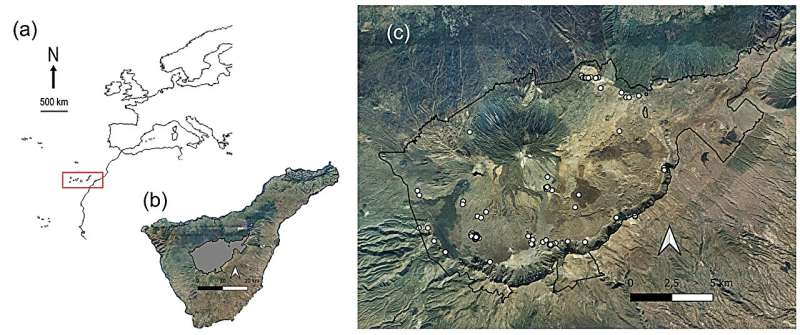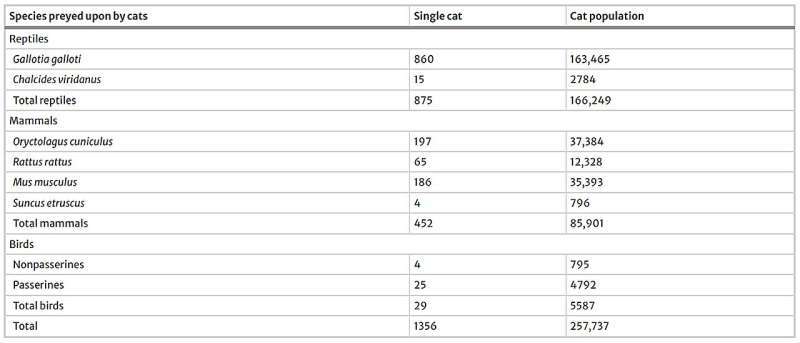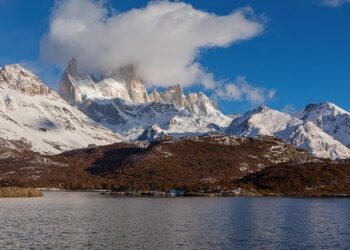
Map showing: a) the location of the Canary Islands (red square), b) the island of Tenerife and the Teide National Park (gray shape), and c) the location of the samples in the National Park (white dots). Credit: Mammal Research (2023). DOI: 10.1007/s13364-023-00728-9
Trophic ecology is the study of the food chain. On Tenerife in the Canary Islands, feral cats feast chiefly on rabbits, mice, rats, and native birds and reptiles. But new research shows that since 1986, the island’s wild cats have experienced a significant shift in their dietary composition, which bodes poorly for several native species.
The study, by a pair of researchers from Universidad de La Laguna in Tenerife, is titled “Shifts in the trophic ecology of feral cats in the alpine ecosystem of an oceanic island: implications for the conservation of native biodiversity” and was published in Mammal Research.
Among predators throughout the world, free-ranging cats pose one of the greatest threats, and existing studies show that the predatory impact of cats is particularly heightened on islands. A 2011 study links 14% of known worldwide extinctions of island birds, mammals, and reptiles to predatory cats.
The Canary Islands, which lie within Macaronesia in the North Atlantic Ocean off the coast of Morocco and the Western Sahara, are a volcanic archipelago consisting of seven main islands and numerous smaller ones. Tenerife, the largest island, includes a number of varying environments, including sandy coastal areas, cloud forest, pine forest, and—at the highest altitudes—alpine scrub, where climate conditions are extreme and endemic species of considerable variation are found in small numbers.
Notably, it is the limited populations and ranges of the animals in areas of alpine scrub that put them at high risk of the effects of climate change and the presence of allochthonous (introduced non-native) species, which include cats.
Trophic behavior of feral cats in the Canary Islands
Earlier studies in the Canaries have shown that feral cats (Felis catus) primarily consume allochthonous mammals including rabbits (Oryctolagus cuniculus), mice and rats, as well as native birds and reptiles.
A 2021 study conducted in the Montaña de Guaza area, in the southern coastal region of Tenerife, showed that compared to 15 years earlier, feral cats were consuming native reptiles comprising more biomass in the cats’ scat (11.5%, up from 3.6%) and native birds comprising more biomass (39%, up from 2.4%), but were consuming rabbits comprising a smaller amount of biomass (30.3%, down from 62.4%).
In this new study, the researchers sought to investigate whether cats in other areas of the island had experienced a similar dietary shift over a period of 35 years. Focusing their 2021 field work in El Teide National Park, an environment rich in alpine scrub, the researchers analyzed 301 scat samples from feral cats and compared the results to earlier data.

Annual numbers of vertebrate intake of both a single cat and the cat population assuming a density of 1 cat/km2 in Teide National Park and considering that 170 g of prey equals one day’s consumption. Credit: Mammal Research (2023). DOI: 10.1007/s13364-023-00728-9
They found that in this locale, while rabbit biomass in the cats’ droppings had represented 73% of the cats’ rabbit consumption in 1986, by 2021 that percentage had dropped to 53.9% due to a diminished number of available rabbits, possibly due to rabbit hemorrhagic disease virus (RHDV and its new variant, RHDV2). Expressed in terms of quantity, by 2021 the cats were eating only about half as many rabbits as they had in 1986.
Comparing these findings to previous data, the researchers observe, “The values obtained in this study are the lowest ever recorded for cat diets in high mountain scrubland in all the Macaronesian islands studied thus far and are among the lowest of all those recorded for the Canary Islands.”
Consequently, the park’s cats have increased their intake of native reptiles and birds. Based on an assumption of one cat per square kilometer of the park’s overall 190 km2, the researchers calculated that each feral cat consumes approximately 1,356 vertebrates each year (including 29 birds, 197 rabbits and 875 reptiles, along with others). This brings the park’s total annual cat predation estimate to 257,737 vertebrates, including 5,587 birds, 37,384 rabbits and 166,249 reptiles, along with others.
Conservation concerns
Because the study data show that feral cats in El Teide National Park are preying upon native species (birds and reptiles) at a rate that comprises two-thirds of their total food intake, the researchers stress the importance of prioritizing management and conservation actions in this area.
In particular, they note that two of the prey species, the Tenerife lizard (Gallotia galloti) and the ring ouzel (Turdus torquatus), serve respectively as short- and long-distance dispersers of cedar seeds in this location.
During the coldest annual period, the ring ouzel and other birds seek food and shelter in areas of cedars, making them easy targets for cats. The team suggests fencing cedar areas to keep cats away and selective trapping of cats as mitigation actions.
More information:
Manuela Gómez-Alceste et al, Shifts in the trophic ecology of feral cats in the alpine ecosystem of an oceanic island: implications for the conservation of native biodiversity, Mammal Research (2023). DOI: 10.1007/s13364-023-00728-9
© 2023 Science X Network
Citation:
‘What’s on today’s menu?’: Why it’s important to study the trophic behavior of local predators (2023, December 28)
retrieved 29 December 2023
from https://phys.org/news/2023-12-today-menu-important-trophic-behavior.html
This document is subject to copyright. Apart from any fair dealing for the purpose of private study or research, no
part may be reproduced without the written permission. The content is provided for information purposes only.
>>> Read full article>>>
Copyright for syndicated content belongs to the linked Source : Phys.org – https://phys.org/news/2023-12-today-menu-important-trophic-behavior.html































